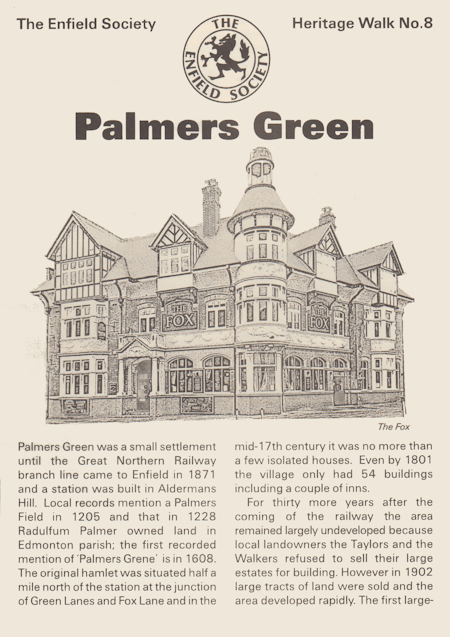 A new self-guided walk booklet will take you around Palmers Green's architectural and heritage highlights and reveal fascinating snippets about our local history. For instance, did you know about the time when three crowned heads of European states got together around a PG table?
A new self-guided walk booklet will take you around Palmers Green's architectural and heritage highlights and reveal fascinating snippets about our local history. For instance, did you know about the time when three crowned heads of European states got together around a PG table?
Heritage Walk No 8 - Palmers Green is the latest in a series of publications by the Enfield Society containing suggestions for self-guided walks around the borough's most historic areas. The circular route, roughly five kilometres long, starts and ends at the railway station, and takes us to 21 numbered points of interest. It was devised by Adrian Day of the Friends of the Lakes Estate in collaboration with the Enfield Society and Southgate District Civic Voice.
The official launch of the booklet by the Enfield Society took place on 11th July in the function room at the Fox - itself included in the guide and, in an earlier form, at the heart of the original pre-Edwardian village of Palmers Green. Invitees were from several local community groups, including Southgate District Civic Voice, Palmers Green Action Team, Friends of Broomfield Park, the Broomfield House Trust and Friends of the Lakes Estate, as well as representatives of Enfield Council's Journeys & Places team and Rev Julie Coleman from St John's Church.
Adrian Day, who compiled the guide, commented: "Palmers Green has a rich Edwardian heritage; hopefully, the walk knits that together in an interesting and engaging way."
Dave Cockle, Chairman of the Enfield Society, said: "The Palmers Green Heritage Walk provides an excellent opportunity to explore the interesting parts of Palmers Green which you wouldn't necessarily pass through."
Churches at either end, and water on both sides
The southernmost and northernmost points of the walk are both churches built at roughly the same time: in the south, adjoining Deadmans Bridge, where Green Lanes crosses the Pymmes Brook (look out for the Traction Engines sign), is the small Arts & Crafts-style New Life Church. Contrasting greatly with this, in the north, is the massive bulk of the Gothic Revival parish church, St John the Evangelist, with its notable war memorial.
On the east-west axis, both ends are characterised by water and recreation: in the east, a stretch of the New River where it flows past Hazelwood Recreation Ground; in the west, Conway Recreation Ground, with its duckpond, was created by the Southgate Urban District Council in 1913 to reclaim a swampy area that the builders of the surrounding streets of large Edwardian houses had chosen to ignore.
In between, plenty of early twentieth century architecture: houses, municipal buildings, churches, banks, schools, shopping parades. A couple of exceptions are Truro House, dating from the 1860s and still for sale if you fancy a move, and, of course, at the centre of our historic park, the ruins of Broomfield House, with its origins in the 16th century.
Kings and emperors around the same table
So what about the three crowned heads of state? The guide reveals that the guest list at a dinner held in 1815 in a mansion that once stood at the top of Aldermans Hill included Czar Alexander I of Russia, Louis XVIII of France, Frederick William III of Prussia and the Prince Regent (soon to be crowned himself, as George IV).
The Palmers Green Heritage Walk booklet is on sale at £2.50. You can buy it, along with the previous seven walks and many other fascinating Enfield Society local history publications, at Waterstones in Enfield Town or online from the Enfield Society Store.



